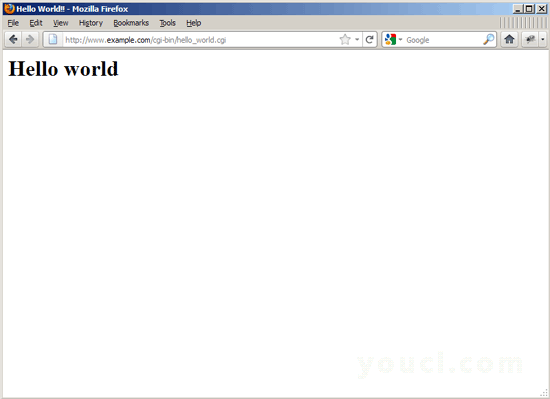在Debian Squeeze / Ubuntu 11.04上为Nginx提供CGI脚本
本教程将介绍如何在Debian Squeeze / Ubuntu 11.04上为nginx提供CGI脚本(Perl脚本)。 虽然nginx本身不服务CGI,但有几种方法可以解决这个问题。 我将概述三个解决方案:第一个是将CGI脚本的代理请求发送给具有CGI支持的小型Web服务器Thttpd,而第二和第三个解决方案非常相似 - 都使用CGI包装器来提供CGI脚本。
我不会保证这将为您工作!
1初步说明
我正在使用网站www.example.com ,其中包含文件根/var/www/www.example.com/web/和Nginx vhost配置文件/etc/nginx/sites-enabled/www.example.com。虚拟主机
Ubuntu用户注意事项:
因为我们必须使用root权限运行本教程的所有步骤,所以我们可以使用字符串sudo在本教程中添加所有命令,也可以通过键入来成为root
sudo su
2使用Thttpd
在本章中,我将介绍如何将nginx配置为向Thttpd提供CGI脚本(扩展名.cgi或.pl )的代理请求。 我将配置Thttpd在端口8000上运行。
首先我们安装Thttpd:
apt-get install thttpd
nginx ThttpdCGI页面说Thttpd应该打补丁 - 幸运的是,这个补丁已经包含在Debian和Ubuntu的thttpd包中,所以我们不需要这样做。
接下来我们打开/ etc / default / thttpd ...
vi /etc/default/thttpd
...并将ENABLED设置为yes :
[...] ENABLED=yes |
然后,我们对原始的/ etc / thttpd / thttpd.conf文件进行备份,然后创建一个新的文件,如下所示:
mv /etc/thttpd/thttpd.conf /etc/thttpd/thttpd.conf_orig
vi /etc/thttpd/thttpd.conf
# BEWARE : No empty lines are allowed! # This section overrides defaults # This section _documents_ defaults in effect # port=80 # nosymlink # default = !chroot # novhost # nocgipat # nothrottles # host=0.0.0.0 # charset=iso-8859-1 host=127.0.0.1 port=8000 user=www-data logfile=/var/log/thttpd.log pidfile=/var/run/thttpd.pid dir=/var/www cgipat=**.cgi|**.pl |
这将使Thttpd在127.0.0.1的 8000端口上监听 ; 其文档根目录是/ var / www 。
开始Thttpd:
/etc/init.d/thttpd start
接下来创建/etc/nginx/proxy.conf :
vi /etc/nginx/proxy.conf
proxy_redirect off; proxy_set_header Host $host; proxy_set_header X-Real-IP $remote_addr; proxy_set_header X-Forwarded-For $proxy_add_x_forwarded_for; client_max_body_size 10m; client_body_buffer_size 128k; proxy_connect_timeout 90; proxy_send_timeout 90; proxy_read_timeout 90; |
现在打开您的vhost配置文件...
vi /etc/nginx/sites-enabled/www.example.com.vhost
...并向服务器{} 容器添加位置/ cgi-bin {}部分:
server {
[...]
location /cgi-bin {
include proxy.conf;
proxy_pass http://127.0.0.1:8000;
}
[...]
} |
重新加载nginx:
/etc/init.d/nginx reload
因为Thttpd的文档根目录是/ var / www ,所以/ cgi-bin将转换为目录/ var / www / cgi-bin (这对所有的vhosts都是这样,这意味着每个vhost必须将其CGI脚本放在/ var / www / cgi-bin ;这是共享宿主环境的一个缺点;解决方案是使用第3章和第4章所述的CGI包装器,而不是Thttpd)。
创建目录...
mkdir /var/www/cgi-bin
...然后将CGI脚本放在其中并使其可执行。 为了测试目的,我将创建一个小的Hello World Perl脚本(而不是hello_world.cgi,你也可以使用扩展名.pl - > hello_world.pl ):
vi /var/www/cgi-bin/hello_world.cgi
#!/usr/bin/perl -w
# Tell perl to send a html header.
# So your browser gets the output
# rather then <stdout>(command line
# on the server.)
print "Content-type: text/html\n\n";
# print your basic html tags.
# and the content of them.
print "<html><head><title>Hello World!! </title></head>\n";
print "<body><h1>Hello world</h1></body></html>\n"; |
chmod 755 /var/www/cgi-bin/hello_world.cgi
打开浏览器并测试脚本:
http://www.example.com/cgi-bin/hello_world.cgi
如果一切顺利,您应该得到以下输出:









